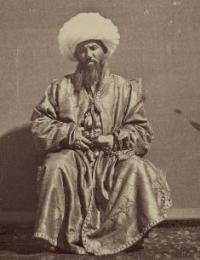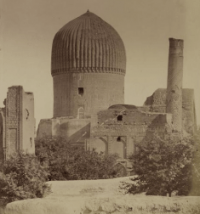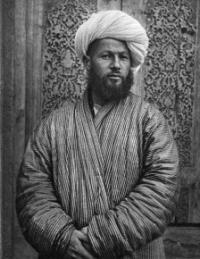You are here
History mausoleum Gur-Emir.




Architectural tours over Samarkand.
“Ancient aphorisms outlived centuries. Modern aphorisms can barеly survive from book to book”
Ljupka Cvetanova.
Package tour in Samarkand and Khiva.
Gur-Emir among those burried here, two men stand out, both famous rulers who have shaped the destiny of Samarkand and made it the pearl of The Great Silk Road. One was a conqueror, the other an enlightener.
One was a general, the other an astronomer. Grandfather and grandson. Amir Temur and Ulug Bek. From the Registan a road leads straight down to a quiet park like square on the left hand side that stretches all the way up to the famous mausoleum from the XV century, the Gur EMir.
On the cross roads, like a guardian, you will first pass the Rukhabad mausoleum, the crypt of Sheikh Burhanuddin Sagarji who died in 1388 and who was Amir Temur's spiritual father and close advisor, a man who held the greatest authority in matters of the Koran and the law.
Today visitors can admire the newly renovated mosque, a pond and the wide and impeccably maintained "Royal Alley" at the end of which the famous blue cupola, the symbol of Gur Emir, majestically beckons you to step closer.
It was Temur's grandson, crown prince Muhammad Sultan, who first gave the order to build a Medresse and adjoining Khanaka for the secular education and training of children from the upper ranks of civil servants.
What remains of the magnificent ensemble is the entrance portal complete with exquisite majolica by Muhammad bin Mahmud Isfahani and part of the southern wall. In 1403, Muhammad Sultan passed away in Persia. A year later, Amir Temur had a grand mausoleum erected with a burial crypt at the southern roofed gallery of the courtyard, for his beloved grandson and in foresight of his own burrial arrangements and that of his immediate male heirs.
Indeed, not long afterwards, in February 1405, hardly into his last campaign, Amir Temur perished on the battle field. In order to prevent unrest, the burial ceremony was kept secret. Temur`s body was embalmed with musk and camphor and he was laid next to Muhammad Sultan.
Later, the two coffins were placed in the underground crypt of the mausoleum, which became known as Gur-Emir, the grave of the Emir. As planned the mausoleum became the family crypt of the Temurid dynasty.
Under Ulug Bek, an open-worked marble trellis was placed around the graves. A dark-green nephrite tombstone was placed upon the grave of Amir Temur into which was chisled the ruler's genealogy.
Next to Amir Temur lie his sons Shakhrukh and Miranshah and his grandsons Muhammad Sultan and Ulug Bek. The well-known Soviet anthoropologist Professor M. M. Gerasimov studied the remains of Amir Temur, of Shakhrukh, Ulug Bek, and Miranshah.
He was able to reconstruct their physical appearance, confirming the accuracy of historical testimony on the lameness and one-handedness of Amir Temur and on the assassination of Ulug Bek.
Gur-Emi two men are buried here among other rulers of Samarkand. One was a conqueror, the other an enlightener. One was a general, the other an astronomer. Grandfather and grandson. Amir Temur and Ulughbek who both shaped the history of The Great Silk Road and indeed of the world each in his very own way.
Authority:
http://www.discovery-central-asia.com







